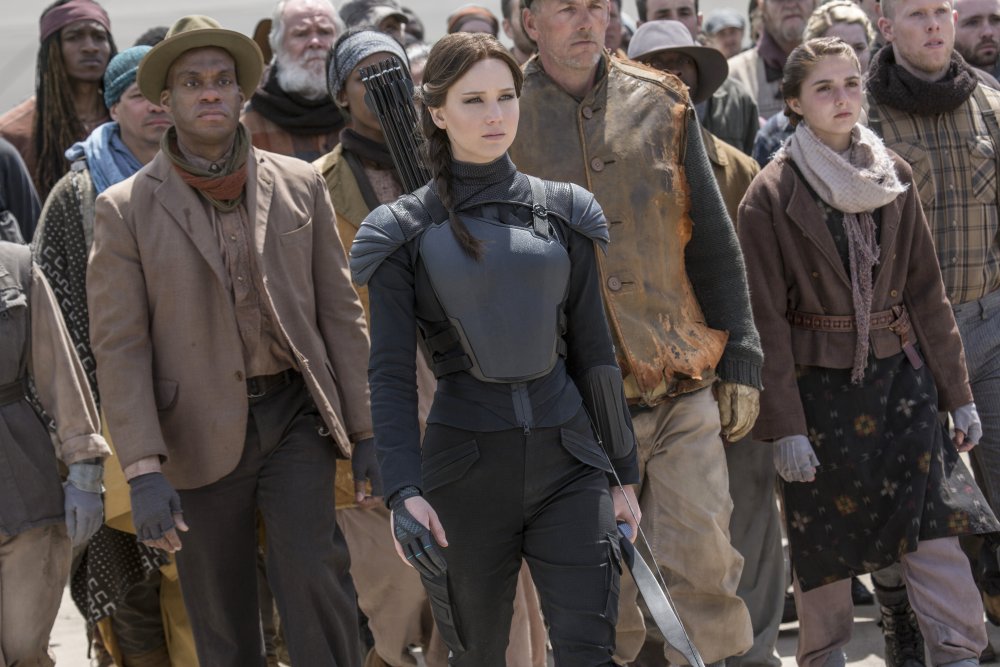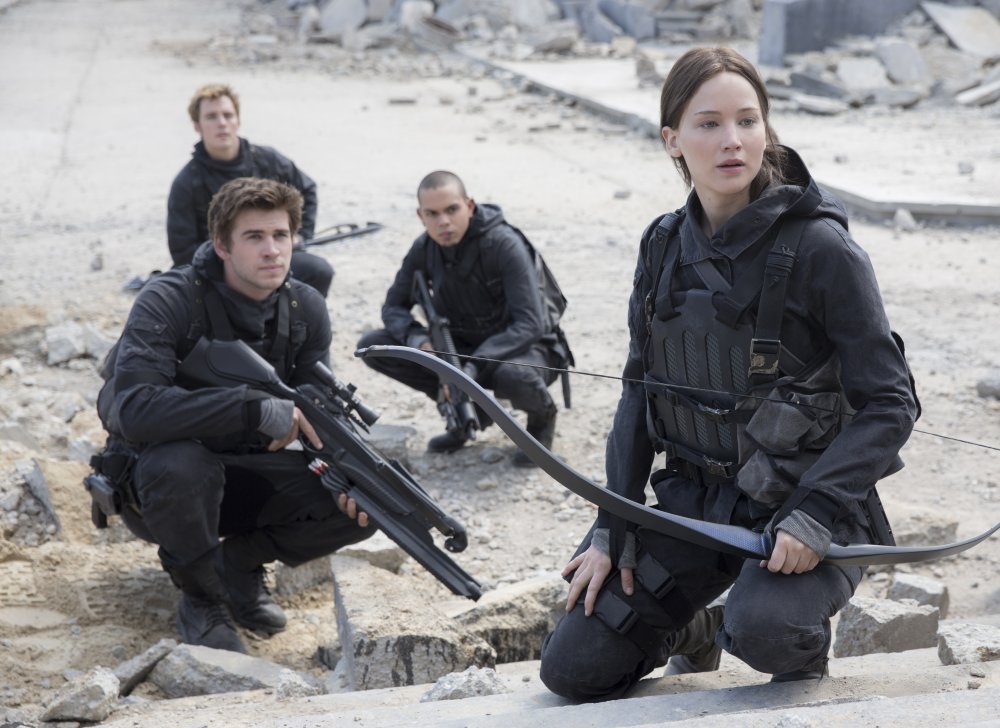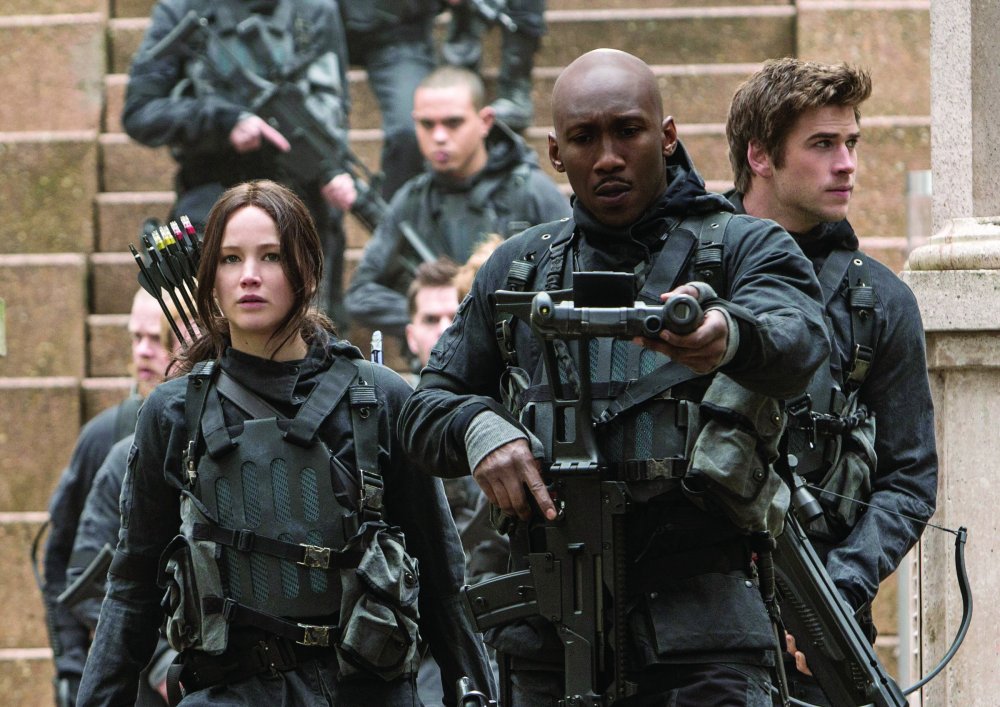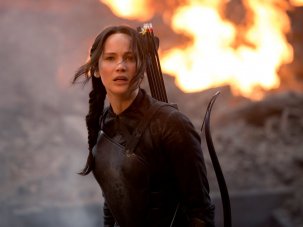Spoiler alert: this review reveals a plot twist
“Ladies and gentlemen, welcome to the 76th Hunger Games.” Although there are no literal games in this fourth film in the series – only a war that draws on their ingenious violence – such is the potency of Suzanne Collins’s mythology that it seems possible it has been around for three-quarters of a century. In fact, it’s only seven years since her first Hunger Games novel was published in 2008, the year of the global crash. As Noreena Hertz observed last April when she named them Generation K, for young millennial women Hunger Games heroine Katniss Everdeen is a defining figure. Born into poverty on the margins of the working class, in a dictatorial society that makes spectacle of brutal blood sport, Katniss is paradigmatic of what Linda Tirado has called “Bootstrap America”, one pay cheque from financial crisis.
USA/Germany 2015
Certificate 12A 136m 45s
Director Francis Lawrence
Cast
Katniss Everdeen Jennifer Lawrence
Peeta Mellark Josh Hutcherson
Gale Hawthorne Liam Hemsworth
Haymitch Abernathy Woody Harrelson
Effie Trinket Elizabeth Banks
President Alma Coin Julianne Moore
Plutarch Heavensbee Philip Seymour Hoffman
Beetee Latier Jeffrey Wright
Primrose Everdeen Willow Shields
Finnick Odair Sam Claflin
Johanna Mason Jena Malone
Cressida Natalie Dormer
Caesar Flickerman Stanley Tucci
President Coriolanus Snow Donald Sutherland
Commander Paylor Patina Miller
Boggs Mahershala Ali
Dolby Atmos/DTS:X
In Colour
Prints by Fotokem
[2.35:1]
Some screenings presented in 3D
3D version 136m 44s
UK release date 19 November 2015
Distributor Lionsgate UK
thehungergames.movie
► Trailer
In this concluding film, which adapts the second half of Collins’s third novel, Katniss finally shifts from passive participant to active protagonist. She has survived two iterations of the deadly reality-TV show created by President Snow as both substitute for and terrifying reminder of the civil war that tore the nation of Panem apart, and has spent several months literally underground, promoted as a figurehead of the rebellion against Snow and his ‘Peacekeepers’. The film begins with her taking the fight first to Alma Coin, the morally ambiguous rebel leader, and then to the Capitol itself. Her aim is pure revenge: despite all the horrors visited on her, it is Snow’s brainwashing of her Games teammate Peeta that finally pushes Katniss into action. A reluctant soldier, she questions the violent intentions of the rebels, particularly the weaponry designed by her former boyfriend Gale with Q-like scientist Beetee.
The equivalence of the corrupt government and the rebel leadership is central to understanding Katniss’s actions in the final book, which the filmmakers have adapted rigorously in terms of its Games-style set pieces – notably the eerie subterranean attack by mutants that forms the movie’s centrepiece – and its less cinematic character arcs. The novel trilogy hinges on Katniss’s first-person narration, which is dominated in the final half of the third book by her experience of pain both physical – she is strangled, shot and burned – and psychological. Although the film opens with a severely bruised Katniss croaking out her key line – “My name is Katniss Everdeen” – it is in the concluding section of the story that it struggles most to convey the emotion of that first-person voice, and needs it most. There are frequent close-ups that showcase Jennifer Lawrence’s extraordinary expressiveness; like Katniss for the rebels, Lawrence is the film’s figurehead, not only its protagonist but also bearing the entire burden of representing its narrative.

While supporting turns from Woody Harrelson as wisecracking alcoholic victor Haymitch, Julianne Moore in chilling mode as Alma Coin, Mahershala Ali as solid soldier Boggs and the late Philip Seymour Hoffman as insidious spin doctor Plutarch Heavensbee continue to give weight and plausibility to the rebels’ underground world, these are more or less cameos in a film whose twin poles are close-ups of Lawrence and thrilling spectacle. The latter includes a perfectly animated tide of liquid metal that chases Katniss and her squad up several storeys of a grand, dilapidated building; the location is reminiscent of post-revolutionary Moscow, a reference the film throws in through its superb production design but can’t explore.
There is a pervasive tension in the films (particularly the final two) between their championing of social justice and their shiny wrapping of super-spectacle. Co-adapter Danny Strong is also co-creator of hip-hop drama Empire, which has commanded record TV audiences in the US through a similar combination of ‘Black Lives Matter’ chants and soap-operatic plots. As a cultural phenomenon, The Hunger Games strikes at the heart of our current political situation: Katniss is a figure of austerity, but she also represents the society of spectacle.

“If we die, let it be for a cause, not a spectacle,” says rebel commander Paylor (another splendid cameo, from Patina Miller) as she rouses the rebel troops before they invade the Capitol. But the film, like the rebels, is caught on the horns of the Hunger Games. Like the earlier sequels it feels the need to replicate the spectacle that gave the first novel its title, but at the same time it decries the politics of spectacle repeatedly. Spectacle, we are told, is what the Capitol delivers on its ever-present transparent screens and digital billboards; as ever, repellent TV host Caesar Flickerman (Stanley Tucci) pops up to call Katniss “the girl on fire”, this time announcing her apparent death in a gun battle.
Yet spectacle is also what Katniss is engaged in for the rebels: the third film was structured around her shooting propaganda videos, or ‘propos’, with tattooed Capitol filmmaker-turned-rebel Cressida (an excellent Natalie Dormer). In the fourth film she is again assigned to propaganda on the streets of the Capitol, making films to convince the city to surrender. Ever cynical and sharply political, Games victor Finnick Odair is spot on when he describes the rebels’ mission in the Capitol as the 76th Hunger Games.
Given this, it’s unsurprising that Peeta has to keep enquiring: “Real or not real?” He’s asking about implanted memories from his brainwashing, but he could equally be referring to a war that is controlled by games-makers, and a film where all battles are media extravaganzas. Katniss’s most stirring speech, following one of the most timely and resonant scenes, in which a trainful of wounded refugees is surrounded by armed rebels, is itself a televisual stunt.

Real or not real: war, politics, leadership, peace-making, even justice – all are mounted as spectacle within the films. This final movie even forgoes the novel’s show trial of President Snow for one snowy, showy conversation between Katniss and her tormentor in his elaborate greenhouse of white roses.
It asserts the real only through Katniss’s relationships, particularly through shot/reverse-shot exchanges with her comrades, and – in the only highly stylised shot of the film – a whirling 360-degree pan that foregrounds her close relationship with her younger sister Prim, whose place she took in the Games right at the start of the story. The film makes slightly more of Prim’s life and death than the book does, giving Katniss her first truly emotional scene when she yells her grief at Prim’s impervious pet cat. The film shifts to naturalism when Katniss returns to the bombed-out, abandoned District 12 (where she finds the cat), intimating a ‘realness’ to home and its relationships in contrast to high drama and affairs of state.
Inevitably, an idealised and golden-lit coda of hunting, playing house and raising children with Peeta follows. This final fantasy points to a deep chasm in the novels, as in American politics, between the championing of what Howard Zinn called “a people’s history” of collective social movements and an anti-statist, individualist, heteropatriarchal libertarianism. While The Hunger Games films’ insistence, right up to the final shots, that traumatised soldiers and civilians can survive and heal is laudable, the Marian closing image of Katniss in a flower-sprigged dress accessorised with a baby is laughable. Her exposition to the impassive child is as much – perhaps more – of an unreal spectacle as all the action that has gone before; simply singing her ‘Mockingjay’ song from the third film would have conveyed her emotions and provided a sense of closure.
Instead, Katniss’s promise to pass the story of the Hunger Games to the next generation, coupled with her distrust of all government, intimates the possibility of a President Paylor-led government re-establishing the Hunger Games, and thus the franchise. Panem et circenses continue to fuel Hollywood and (arguably) also the social status quo, a closed system too massive for even Lawrence’s all-conquering Katniss Everdeen to defeat.
-
The Digital Edition and Archive quick link
Log in here to your digital edition and archive subscription, take a look at the packages on offer and buy a subscription.








